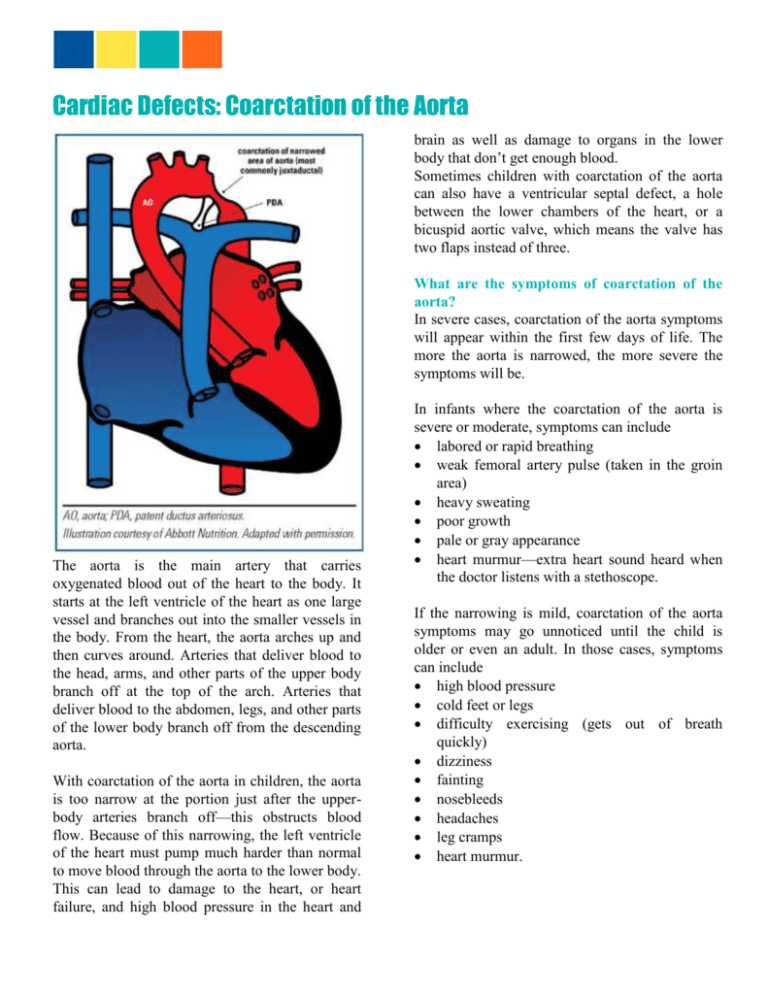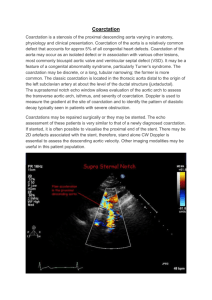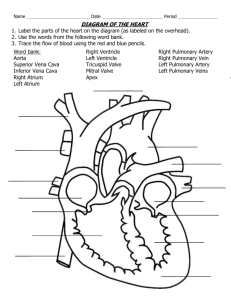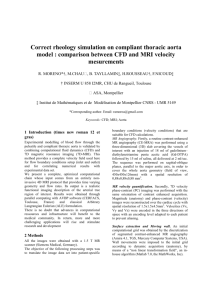English Word File - Baby Steps to Home
advertisement

Cardiac Defects: Coarctation of the Aorta brain as well as damage to organs in the lower body that don’t get enough blood. Sometimes children with coarctation of the aorta can also have a ventricular septal defect, a hole between the lower chambers of the heart, or a bicuspid aortic valve, which means the valve has two flaps instead of three. What are the symptoms of coarctation of the aorta? In severe cases, coarctation of the aorta symptoms will appear within the first few days of life. The more the aorta is narrowed, the more severe the symptoms will be. The aorta is the main artery that carries oxygenated blood out of the heart to the body. It starts at the left ventricle of the heart as one large vessel and branches out into the smaller vessels in the body. From the heart, the aorta arches up and then curves around. Arteries that deliver blood to the head, arms, and other parts of the upper body branch off at the top of the arch. Arteries that deliver blood to the abdomen, legs, and other parts of the lower body branch off from the descending aorta. With coarctation of the aorta in children, the aorta is too narrow at the portion just after the upperbody arteries branch off—this obstructs blood flow. Because of this narrowing, the left ventricle of the heart must pump much harder than normal to move blood through the aorta to the lower body. This can lead to damage to the heart, or heart failure, and high blood pressure in the heart and In infants where the coarctation of the aorta is severe or moderate, symptoms can include labored or rapid breathing weak femoral artery pulse (taken in the groin area) heavy sweating poor growth pale or gray appearance heart murmur—extra heart sound heard when the doctor listens with a stethoscope. If the narrowing is mild, coarctation of the aorta symptoms may go unnoticed until the child is older or even an adult. In those cases, symptoms can include high blood pressure cold feet or legs difficulty exercising (gets out of breath quickly) dizziness fainting nosebleeds headaches leg cramps heart murmur. How is coarctation of the aorta diagnosed in children? When an infant has severe coarctation of the aorta, in most cases a doctor in the birth hospital will notice symptoms. Milder cases of coarctation of the aorta sometimes aren’t diagnosed until the child is older. Healthcare providers refer children to cardiologists for evaluation after parents notice symptoms or if the child has high blood pressure. Diagnosis of coarctation of the aorta may require some or all of these tests: echocardiogram—sound waves create an image of the heart electrocardiogram (ECG)—a record of the electrical activity of the heart chest X ray pulse oximetry—a noninvasive way to monitor the oxygen content of the blood cardiac catheterization—a thin tube is inserted into the heart through a vein and/or artery in either the leg or through the umbilicus (“belly button”) cardiac MRI—a three-dimensional image shows the heart’s abnormalities. What are the treatment options for coarctation of the aorta? Coarctation of the aorta requires either cardiac catheterization or open-heart surgery, depending on the severity of the narrowing and on other factors, such as the child’s age and overall health. Surgeons can remove the narrowed section of the aorta and then sew the ends of the aorta back together, or they can enlarge the aorta with a patch. In catheterization, a cardiologist will thread a thin tube (catheter) with a balloon on the end of it through an artery in the leg up to the heart. Then, using the catheter, the cardiologist can inflate the balloon in the narrowed section of the aorta to open it, and might also place a stent, or a stiff metal cage, to keep it open. Your child will recover from these procedures in the intensive care unit. What is the follow-up care for coarctation of the aorta? Through Age 18 Most children who have repair of coarctation of the aorta recover completely and won’t require additional procedures. Rarely, the aorta becomes narrow again and balloon catheterization or surgery will be required. Pediatric cardiologists follow patients until they are young adults, coordinating care with the primary care provider. Patients will need to carefully follow healthcare providers’ advice. Sometimes, these children can have persistently elevated blood pressure, despite removal of the obstruction. These children will need to take medicines to lower their blood pressure and may need to avoid certain isometric activities, like football, weight-training, and wrestling. Into Adulthood It is important that children born with coarctation of the aorta continue to see a cardiologist. We will help patients transition care to an adult cardiologist. Because of enormous strides in medicine and technology, today most children born with coarctation of the aorta go on to lead productive lives as adults. Adapted with permission. © The Children’s Hospital of Philadelphia.




